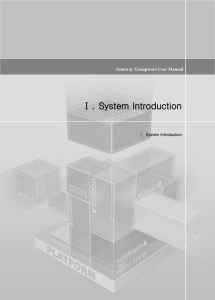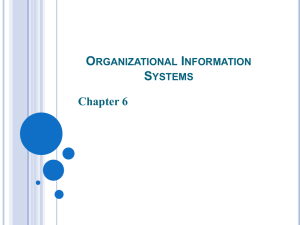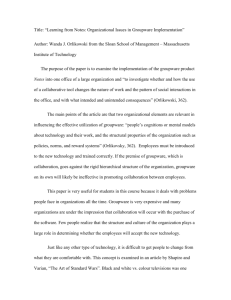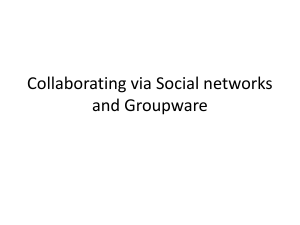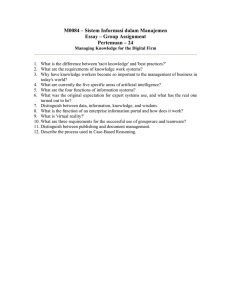groupware
advertisement
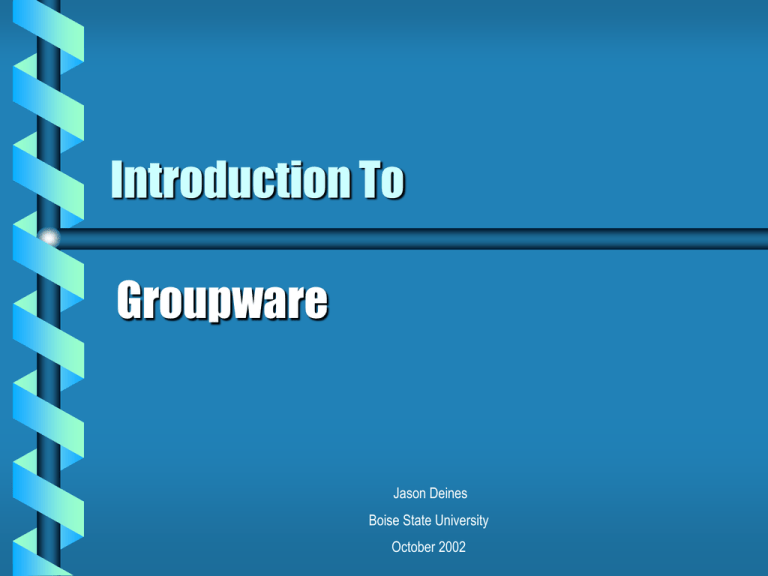
Introduction To
Groupware
Jason Deines
Boise State University
October 2002
Objectives
What is Groupware
Why organizations use Groupware
Categories of Groupware
Barriers to Groupware
Getting Groupware to work in your
organization
Three common definitions of
Groupware
“An intentional group process plus
software to support it.” Peter and Trudy
Johnson-Lenz, 1978.
“A co-evolving human tool.” Doug Englebart,
1988.
“Computer-mediated collaboration that
increases the productivity or functionality
of person-to-person processes.” David
Coleman, 1992.
Why organizations are using
Groupware
Quality improvement
Better cost control
Increased productivity
Better customer service
Support for TQM
Allows for fewer meetings
Automating routine processes
Provide new services
Why organizations are using
Groupware continued...
There are technological infrastructures
available to support Groupware
Decreasing cost for purchasing the
hardware and software
Downsizing is increasing the need for
greater productivity
Well known companies are offering
Groupware
Why organizations are using
Groupware continued...
Increased competition
Increased complexity in products and
business procedures
Five basic categories for
Groupware product
Email/messaging
Group calendaring
and scheduling
Conferencing products
Workflow tools
Group document handling
Email/messaging
The difference between email and
messaging
• email is an application used to read and create
electronic mail messages
• messaging is the electronic infrastructure
upon which email resides. Messaging consists
of two components:
– the user (front end)
– messaging services (back end)
Examples of email/messaging
products available
cc:Mail {Lotus Development}
Microsoft Mail/Exchange
Intelligent Mail {Banyan}
MHS {Novell}
Time and Place/2 {IBM}
Group calendaring and
scheduling
Helps organizations track and manage
schedules of individuals within an
organization
Assists in communication
Saves time
Lowers costs
Schedule across multiple time zones
Real World Example
Scheduling scenario
• CE Software, Inc.
– Marketing department
The scheduling scenario:
An emergency meeting was called, concerning cutting
costs. The meeting needed to be held by the end of the
day on Friday. The four managers needed for the
meeting were spread out doing other projects at
different locations.
Coleman, Khanna, “Groupware
Technology and Applications” Prentice
Real World Example Continued...
The biggest problem
• getting the managers together for an hour by
the end of Friday
Coleman, Khanna, “Groupware
Technology and Applications” Prentice
Real World Example Continued...
Without group calendaring and scheduling
• call the managers on the phone
• leave messages
• discovering the managers won’t be back for
some time
• email managers and wait for a response
• frustration builds due to not being able to get a
hold of the four managers
Coleman, Khanna, “Groupware
Technology and Applications” Prentice
Real World Example Continued...
With group calendaring and scheduling
•
•
•
•
•
open up the scheduling application
select the managers needed for the meeting
do a “free time search”
schedule the meeting
leave a brief message describing the purpose
of the meeting
Coleman, Khanna, “Groupware
Technology and Applications” Prentice
Conferencing/EMS (Electronic
Meeting System)
Brings people together over large
distances
Saves time
Lowers travel expenses
Increase productivity
Assists in increased involvement of
employees
Conferencing/EMS continued...
What is EMS?
• EMS is typically a network of personal
computers. One for each person involved in
the meeting.
• Collection of computer based tools.
– Brainstorming tool
– idea organizer
– voting tools
– focus group discussion tools
Examples of conferencing
products available
ShowMe 2.0 {Sun Solutions}
Lotus Notes {Lotus Development}
Oracle Office {Oracle Systems}
Team Talk {Trax Softworks}
The Meeting Room {Eden Systems}
Workflow
Workflow is the automation and
management of business processes.
Workflow consists of:
•
•
•
•
Tasks-collection of activities
People
Tools-business applications
Data
Examples of workflow products
available
Workflow Analyst {ATI}
Flowmark {IBM}
JetForm {JetForm Corp.}
Staffware for Windows {Staffware}
Formflow {Delrina Inc.}
Group document handling
With the use of document management
systems, organizations can:
• manage large amounts of documents
• share digital documents opposed to paper
documents
• allow group editing
• maintains document databases
• links documents and people
Examples of group document
handling products available
Face-to-Face {Crosswise}
Workflo {FileNet}
Documentum {Documentum, Inc.}
MarkUp {Mainstay Software}
Groupware barriers
Technical
Cultural
Economic
Political
Confusion
Brainstorming exercise
How can you get Groupware to succeed in
your organization?
Getting Groupware to work in
your organization
Find a champion or sponsor to support the
implementation of Groupware
Plan for changes in the corporate culture
Don’t try to implement Groupware to the
whole organization all at once
• Pilot project should be
– innovative
– visible and have a financial impact
Coleman, Khanna, “Groupware Technology and Applications” Prentice Hall, 1995
Getting Groupware to work in
your organization continued...
Realize that training, maintenance, and
support will be the majority of the cost
Use software to solve specific business
problems which hasn’t been solved using
the traditional methods
Have adequate planning, support, training,
and maintenance for your project
Coleman, Khanna, “Groupware
Technology and Applications” Prentice
Getting Groupware to work in
your organization continued...
No single Groupware product can do it all
Use internal people or consultants to
ensure your project’s success
Realize Groupware is not a quick fix
Get user involvement
Be prepared for resistance from employees
Coleman, Khanna, “Groupware
Technology and Applications” Prentice
Conclusion
Groupware is a tool to help solve specific
business problems
Need to overcome barriers
Determine the right software for your
specific purposes
Get the users involved in the planning
phase
Resources
Http://www.groove.net
Coleman, Khanna, “Groupware Technology and
Applications” Prentice Hall, 1995.
Briggs, R.O. “The Focus Theory of Group Productivity and
its Application to the Development and Testing of
Electronic Group Support Technology.” Unpublished
Doctoral Dissertation, MIS Department, University of
Arizona, Tucson, 1994.
Diehl, M. and Stroebe, W. “Productivity Lost in
Brainstorming Groups: Toward the Solution of a Riddle.” J.
Personality and Social Psychology, 53, 3, 1987, 497-509.
